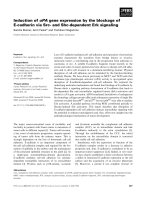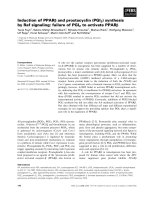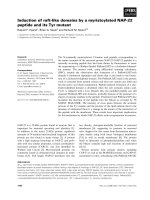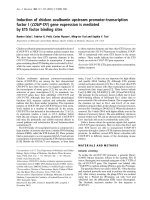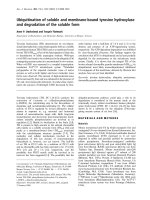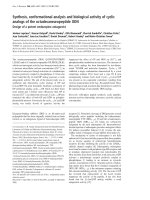Báo cáo y học: "Induction of HSPA4 and HSPA14 by NBS1 overexpression contributes to NBS1-induced in vitro metastatic and transformation activity" potx
Bạn đang xem bản rút gọn của tài liệu. Xem và tải ngay bản đầy đủ của tài liệu tại đây (639.99 KB, 6 trang )
RESEA R C H Open Access
Induction of HSPA4 and HSPA14 by NBS1
overexpression contributes to NBS1-induced in
vitro metastatic and transformation activity
Chung-Yin Wu
1†
, Chih-Ta Lin
2,3†
, Min-Zu Wu
2
, Kou-Juey Wu
2*
Abstract
Background: Nijmegen breakage syndrome (NBS) is a chromosomal-instability sy ndrome associated with cancer
predisposition, radiosensitivity, microcephaly, and growth retardation. The NBS gene product, NBS1 (p95) or nibrin,
is a part of the MRN complex, a central player associated with double-strand break (DSB) repair. We previously
demonstrated that NBS1 overexpression contributes to transformation through the activation of PI 3-kinase/Akt.
NBS1 overexpression also induces epithelial-mesenchymal transition through the Snail/MMP2 pathway.
Methods: RT-PCR, Western blot analysis, in vitro migration/invasion, soft agar colony formation, and gelatin
zymography assays were performed.
Results: Here we show that heat shock protein family members, A4 and A14, were induced by NBS1
overexpression. siRNA mediated knockdown of HSPA4 or HSPA14 decreased the in vitro migration, invasion, and
transformation activity in H1299 cells overexpressing NBS1. However, HSPA4 or HSPA14 induce d activity was not
mediated through MMP2. NBS1 overexpression induced the expression of heat shock transcription factor 4b
(HSF4b), which correlated with the expression of HSPA4 and HSPA14.
Conclusion: These results identify a novel pathway (NBS1-HSF4b-HSPA4/HSPA14 axis) to induce migration,
invasion, and transformation, suggesting the activation of multiple signaling events induced by NBS1
overexpression.
Introduction
Nijmegen breakage syndrome (NBS) is a chromosomal-
instability syndrome associated with cancer predisposition,
radiosensitivity, microcephaly, and growth retardation
[1-3]. The NBS gene product, NBS1 (p95 or nibrin), is a
part of the MRN complex, a central player associated with
DNA double-strand break (DSB) repair [1,2]. NBS1 carries
out its checkpoint functions when it is phosphorylated by
ATM (ataxia-telangiectasia mutated) protein after ionizing
radiation [4-6]. We previously demonstrated that c-MYC,
a dominant oncoprotein, directly activates NBS1
expression [7]. The proliferation-inducing function of
NBS1 is supported by the phenotypes of diminished
expansion of the inner cell mass of mutant blastocysts
(Nbs1 null) and cellular proliferation defects in
Nbs1
m/m
mouse embryonic fibroblasts (MEFs) [8-10].
NBS1 overexpression induces/enhances transformation
activity through the activation of PI 3-kinase/Akt [ 11],
indicating that overexpression of NBS1 is an oncogenic
event. Increased NBS1 expre ssion is also a prognostic
factor for advanced stage head and neck squamous cell
carcinoma (HNSCC) [12]. NBS1 interacts with the
p110 subunits of PI 3-kinase to activ ate PI 3-kinase
activity [13]. All these results implicate that NBS1
overexpression may play a significant role in tumor
progression and metastasis.
Epithelial-mesenchymal transition (EMT) is a process
initially observed in embryonic development in which
cells lose epithelial characteristics and gain mesenchy-
mal properties such as increased migration and in vasion
[14,15]. EMT is a critical event for tumor progression
and metastasis of late-stage cancers [14,15]. Among
the different EMT regulators, Snail induces matrix
* Correspondence:
† Contributed equally
2
Institutes of Biochemistry and Molecular Biology, National Yang-Ming
University, Taipei 112, Taiwan
Full list of author information is available at the end of the article
Wu et al. Journal of Biomedical Science 2011, 18:1
/>© 2011 Wu et a l; licensee BioMed Central Ltd. This is an Open Access art icle distributed under the terms of the Creative Commons
Attribution License ( which permits unrestricted use, distribution, and reproduction in
any medium, provided the original work is properly cited.
metalloproteinase-2 (MMP2) expression and contributes
to increased invasiveness through the inhibition of cell-
cell adhesion [16]. We recently demonstrated that NBS1
overexpression induces EMT through the Snail/MMP2
pathway [17], supporting the role of NBS1 overexpres-
sion in tumor progression and metastasis.
HSPA4 (Apg-2, HSP70) is considered to be a member
of the Hsp110 family since it has a chaperone-like activ-
ity similar to Hsp110 [18,19]. HSPA4 responds to acidic
pH stress, is involved in the radioadaptive response, and
is overexpressed in hepatocellular c arcinoma [19-21].
HSPA14 (Hsp70L1, HSP70-4) is expressed in the lens of
zebrafish, forms the mammalian ribosome-associated
complex with MPP11, and acts as a Th1 adjuvant
through activation of dendritic cells [22-25]. Heat shock
transcription factor 4b (HSF4b) is derived through alter-
native splicing and acts as a transcription activator [26].
HSF4b could be activated b y the MAPK/ERK pathway
and also recruits Brg1 during the G1 phase to regulate
downstream heat shock proteins [27,28].
In this report, we demonstrate that NBS1 overexpres-
sion induced the expression of two heat shock proteins,
HSPA4 and HSPA14. siRNA mediated repression of
HSPA4 or HSPA14 decreased the in vitro migration,
invasion, and transformation activity of NBS1 overex-
pressing cells. Induction of HSPA4 and HSPA14 did not
overlap with the MMP2 pathway previously shown [17].
HSF4b expression correlated with the expression of
HSPA4 and HSPA14. These results demonstrate the
distinct pathway induced by NBS1 overexpression to
enhance the in vitro metastatic and transformation
activity in contrast to the Snail/MMP2 pathway [17].
Materials and methods
Cell lines, plasmids, and transfections
The non-small cell lung cancer cell line H1299 and
human head and neck squamous cell carcinoma cell
line FADU was previously described [12,17]. The
pHeBOCMVNBS plasmid were described [11,12].
The FADUNBS1 cell line w as described [12].
The H1299NBS1 stable clones were generated by trans-
fecting the pHeBOCMVNBS construct into H1299 cells.
The pHeBOCMV or pSUPER plasmid was stably trans-
fected into FADU cells to generate the vector control
cell lines. The pSUPER-HSPA4i and pSUPER-HSPA14i
plasmids were made as described [11,12]. The oligonu-
cleotides inserted into the pSUPER plasmid were
described in additional file 1.
Western blot analysis, RNA purification and RT-PCR
analysis
Western blot analysis was performed as described
[11-13]. For Western blot analysis, 50 μgprotein
extracts from each clone were loaded to 10% SDS-PAGE
gels and transferred to nitrocellulose filters. The filters
were probed with an anti-NBS1 antibody [11- 13] and an
anti-ß-actin antibody was selected a s a loading control.
Signals were developed using an ECL chemilumines-
cence kit (Amersham Biosciences, U.K.). Trizol (Invitro-
gen Life Technologies, Carlsbad, CA) was used for RNA
purification from cultured cells. One μgofRNAwas
used for cDNA synthesis followed by PCR to evaluate
the mRNA expression of NBS1, HSPA4, HSPA14,
MMP2, H SF4b, HSF1, and HSF2 in different cell lines.
The p rimer sequences used in RT-PCR were described
in additio nal file 1. Since the antibodies against HSPA4,
HSPA14, and HSF4b are not commercially available,
only RT-PCR analysis could be used to analyze the
expression levels of these molecules.
In vitro cell migration and invasion assay
The procedures were performed as described [29,30].
Briefly, eight- μmporesizeBoydenchamberwasused
for in vitro migration and invasion assays. Cells (1 ×
10
5
) in 0.5% serum-containing RPMI were plated in the
upper chamber and 15% feta l bovine serum was ad ded
to RPMI 1640 in the lower chamber as a chemoattrac-
tant. For invasion assay, t he upper side of the filter was
covered with Matrigel (Collaborative Researc h Inc.,
Boston, MA)(1:3 dilution with RPMI). After 12 hours
for migration assay or 24 hours for invasion assay, cells
on the upper side of the filter w ere removed, and cells
that remained adherent to the underside of membrane
were fixed in 4% formaldehyde and stained with
Hoechst 33342 dye. The number of migrated cells was
counted using a fluorescence microscope. Ten contigu-
ous fields of each sample were examined using a 40×
objective to obtain a representative number of cells
which migrated/invaded across the membrane.
Soft agar colony formation assay
The stable clones were plated at three different cell den-
sity (5 × 10
3
,10
4
,2×10
4
or 2.5 × 10
3
,5×10
3
,10
4
)
using standard assay conditions as mentioned except
that 15% FCS was used [11,12]. D ata shown are repre-
sentative of two o r more experime nts from independent
cell cultures.
Gelatin Zymography
Gelatin zymography was carried by subjecting 5 μgof
each conditioned media sample to 10% SD S-PAGE con-
taining 0.1% gelatin (G-9382, Sigma-Aldrich Corp., St.
Louis, MO) as previously described [17]. Gels were
stained with Coomassie Brilliant Blue R-250 and then
destained. Transparent bands identi fied at 72 kD (latent
form of MMP2) and 66 kD (active form of MMP2) on
theCoomassiebluebackgroundofthegelwereconsid-
ered positive for the presence of enzymatic activity.
Wu et al. Journal of Biomedical Science 2011, 18:1
/>Page 2 of 6
Statistical analysis
Pearson Chi-square or Fisher’sexacttestswereusedfor
comparison of dichotomous variables between groups,
and the independent Student’s t-test was used to com-
pare the continuous variables between t wo groups
[17,29,30]. The leve l of statistical significance was set at
0.05 for all tests.
Results
NBS1 overexpression in H1299 cells increased in vitro
migration and invasion activity and induced the
expression of HSPA4 and HSPA14
We previously demonstrated that NBS1 overexpression
induces epithelial-mesenchymal transition in head and
neck cancer cell lines [17]. We wanted to test whether
NBS1 overexpression could also increase in vitro migra-
tion and invasion activity in a lung cancer cell line.
NBS1 expression vector was transfected into H1299
cells and stable clones were generated (Figure 1A). In
vitro migration and invasion activity were measured in
H1299NBS1 cell clones vs. the H1299 control clones.
The results showed that NBS1 overexpression increased
the in vit ro migration and invasion activity compared
with the control clones (Figure 1B).
To investigate the downstream signaling pathways
responsible for NBS1-induced migration and invasion
activity, a microarray a pproach was used to screen for
genes activated by NBS1 overexpression. Among the
numerous candidates, we focused on two heat shock
proteins (HSPA4 and HSPA14) since many hea t shock
proteins such as HSP60, HSP90, GRP78, HSP27, and
HSP70 were involved in metastasis [30-33]. In addition,
these two proteins were not investigated to play a role
in migration and invasion activity and may represent
targets which have novel fu nctions related to metast asis.
To verify the results from microarray screen ing, a RT-
PCR assay was performed to examine the incr ease in
mRNA levels of HSP A4 and HSPA14. The result
showed that the expression levels of HSPA4 and
HSPA14 increased in two different NBS1 overexpressing
cell lines (FADUNBS1 vs. FADU control; H1299NBS1
vs. H1299 control) (Figure 1C). These results confirmed
the ability of NBS1 to induce in vitro metastatic activi ty
in a lung cancer cell line and also identified the possible
downstream targets of NBS1 overexpression.
Knockdown of HSPA4 or HSPA14 decreased in vitro
migration and invasion activity
To test the role of HSPA4 and HSPA14 in in vitro migra-
tion and invasion activity, siRNA-mediat ed repression of
HSPA4 or HSPA14 was carried out in H1299 cells using
transient transfection methods. The results showed that
transient expression of siRNA against HSPA4 or HSPA14
caused a significant decrease in the mRNA levels of
HSPA4 or HSPA14 in H1299 cells compa red to the con-
trol-transfected cells (Figure 2A, C). In vitro migration and
invasion activity also decreased in H1299 cells receiving
siRNA to repress HSPA4 or HSPA14 (Figure 2B, D). To
Figure 1 NBS1 overexpression induced in vitro migration and
invasion activity of H1299 cells and the expression of HSPA4
and HSPA14. (A) Western blot analysis of NBS1 levels in
H1299NBS1 clones vs. H1299 control clones. (B) NBS1
overexpression increased the migration and invasion activity of
H1299 cells. The asterisk (*) indicated statistical significance (P <
0.05) between H1299NBS1 and H1299-control clones. (C) Induction
of HSPA4 and HSPA14 expression by NBS1 overexpression in two
different cell lines (FADU control vs. FADUNBS1, H1299 control vs.
H1299NBS1).
Figure 2 Transient expression of siRNA against HSPA4 or
HSPA14 in H1299 cells decreased the in vitro migration and
invasion activity. (A) &(C) Transient transfections of pSUPER-
HSPA4i or pSUPER-HSPA14i decreased the expression of
endogenous HSPA4 or HSPA14 in H1299 cells. (B) & (D) A
significant decrease in migration and invasion activity in H1299 cells
was shown by transient transfections of pSUPER-HSPA4i or pSUPER-
HSPA14i vector into H1299 cells. The asterisk (*) indicated statistical
significance (P < 0.05) between pSUPER vector control transfections
vs. pSUPER-HSPA4i or pSUPER-HSPA14i transfections.
Wu et al. Journal of Biomedical Science 2011, 18:1
/>Page 3 of 6
test the contribution of HSPA4 or HSPA14 to NBS1-
induced migration and invasion activity, siRNA-mediated
knockdown of HSPA4 or HSPA14 in H1299NBS1 cells
wasperformed.StableclonesexpressingsiRNAagainst
HSPA4 or HSPA14 were generated followed by the assay
of in vitro migration and invasion activity. The results
showed that knocking down HSPA4 or HSPA14 in
H1299NBS1 cells c aused a significant decrease in the in
vitro migration and invasion activity, demonstrating the
contribution of HSPA4 or HSPA14 to NBS1-induced
migration and invasion activity (Figure 3B, D) . However,
knockdown of HSPA4 and HSPA14 in H1299 cells simul-
taneously did not further decrease the in vitro migration
and invasion activity (additional file 2), suggesting the
overlapping role of HSPA4 and HSPA14.
Knockdown of HSPA4 or HSPA14 decreased in vitro
transformation activity
We previously demonstrated that NBS1 overexpression
contributes to transfo rmation through the activation of
PI 3-kinase/Akt [11]. To test the role of HSPA4 or
HSPA14 in the transformation activity induced
by NBS1, siRNA mediated repression of HSPA4 or
HSPA14 in H1299NBS1 cells was performed (Figure 3A,
C). The results s howed a significant decrease in soft
agar colony formation activity in H1299NBS1 stable
clones expressing siRNA against HSPA4 or HSPA14
(Figure 4A, B), suggesting the contribu tion of HSPA4 or
HSPA14 to in vitro transformation activity.
Knockdown of HSPA4 or HSPA14 did not influence the
expression or activity of MMP2 and the correlation of
HSF4b expression with HSPA4/HSPA14 expression
SincewepreviouslyshowedthatNBS1overexpression
induced epithelial-mesenchymal transition through the
Snail/MMP2 pathway [17], we wanted to test whether
MMP2 activity overlapped with the activity of HSPA4
or HSPA14. Gelatin zymography experiments showed
that there was no decrease in pro-MMP2 or active
MMP2 activity when either HSPA4 or HS PA14 were
knocked down by siRNA (first lane of Figure 5A, B ).
There was no decrease in the mRNA levels of MMP 2 in
H1299NBS1 stable clones receiving siRNA against
HSPA4orHSPA14(lowerlanesofFigure5A,B).This
result suggests that the p athways of HSPA4 or HSPA14
did not overlap with the Snail/MMP2 pathway pre-
viously shown [17]. To screen for the upstream signaling
which may induce the expression of HSPA4 or HSPA14,
RT-PCR analysis of different heat shock transcription
factors was performed. The result showed that the
mRNA levels of HSF4b, but not HSF1 or HSF2, corre-
lated with t he expression of HSPA4 and H SPA14
(Figure 5C). This result suggests that HSF4b may be the
transcription factor inducing the activation of HSPA4 or
HSPA14 in NBS1 overexpressing cells.
Discussion
Overexpression of NBS1 was previously shown to
induce transformation through the PI 3-kinase/Akt
pathway and epithelial-mesenchymal transition through
the Snail/MMP2 pathway [11-13,17]. However, NBS1
may activate other pathways that promote EMT and
metastasis since ~9% of metastatic head and neck can-
cer patient cases belonged to the NBS1(+)/Snail(-)
group in our previous study [[17] and data not shown].
Figure 3 H1299NBS1 stable clones expressing siRNA against
HSPA4 or HSPA14 decreased the in vitro migration and
invasion activity. (A) & (C) H1299NBS1 clones stably transfected
with pSUPER-HSPA4i or pSUPER-HSPA14i vector showed the
decreased expression of endogenous HSPA4 or HSPA14 in
H1299NBS1 cells. (B) & (D) A significant decrease in migration and
invasion activity was shown in H1299NBS1 cells receiving siRNA
against HSPA4 or HSPA14. The asterisk (*) indicated statistical
significance (p < 0.05) between H1299NBS1 clones expressing siRNA
and H1299NBS1 control clones.
Figure 4 H1299NBS1 clones expressing siRNA against HSPA4
or HSPA14 decreased the soft agar colony formation activity.
(A) &(B) A significant decrease in soft agar colony formation activity
was shown in H1299NBS1 cells receiving siRNA against HSPA4 or
HSPA14. The asterisk (*) indicated statistical significance (p < 0.05)
between H1299NBS1 clones expressing siRNA and H1299NBS1
control clones.
Wu et al. Journal of Biomedical Science 2011, 18:1
/>Page 4 of 6
In this report, we demonstrated that NBS1 overexpres-
sion induced the expression of HSPA4 and HSPA14,
two heat shock proteins. In addition, HSPA4 and
HSPA14 contrib uted to the in vitro migration, invasion,
and transformation activity using siRNA approaches,
which is independent of MMP2 activity induced by
NBS1 [17]. HSF4b could be the possible heat shock
transcription factor which may cause the activation of
HSPA4 and HSPA14. These results demonstrate the
alternative pathway to induce in vitro metastatic and
transformation activity when NBS1 is overexpressed.
Although NBS1 overexpression was shown to induce PI
3-kinase/Akt act ivity [11-13], no putative Akt phosphor-
ylation sites could be identified from the protein
sequence of HSF4b. Since HSF4b was shown to be
phosphorylated by ERK to increase its DNA binding
activity [27], it will be interesting to test whether the
ERK activity could be induced by NBS1 overexpression,
leading to the phosphorylation of HSF4b.
HSPA4 and HSPA14 are two heat shock protein
family memb ers whose functions were not shown to b e
related to metastasis or transformation [18,20-25]. It is
intriguing that siRNA mediated repression of either
HSPA4 or HSPA14 caused a significant decrease in in
vitro migration, invasion, and transformation activity.
However, it appears that the role of HSPA4 and
HSPA14 is overlapping since knockdown o f both mole-
cules did not further decrease the in vitro migration and
invasion activity (additional file 2). Whether HSPA4 and
HSPA14 regulate the same molecules to mediate metas-
tasis remains to be explored. Our results uncovered the
novel functions of the se two heat shock proteins and
delineated new roles of these two proteins in tumor
metastasis and transformation. Increased HSPA4 levels
were observed in hepatocellular carcinoma [19], which
supports our observation.
Conclusion
Our results indicate that NBS1 overexpression in cancer
cells induces EMT and transformation through the acti-
vation of distinct pathways. This discovery provides
valuable information for thediagnosis/prognosisand
future target of anti-metastasis therapy in cancer
patients.
Additional material
Additional file 1: supplementary table 1. the table contains sequences
of oligonucleotides and primers used in the generation of pSUPER siRNA
constructs and RT-PCR.
Additional file 2: supplementary figure 1. Simultaneous knockdown of
HSPA4 and HSPA14 did not further decrease the in vitro migration and
invasion activity in H1299 cells. (A) RT-PCR analysis of H1299 cells with
knockdown of HSPA4, HSPA14, or both. (B) The in vitro migration and
invasion activity of H1299 cells with knockdown of HSPA4, HSPA14, or
both.
List of abbreviations
NBS: Nijmegen breakage syndrome; MRN: Mre11-Rad50-NBS1; HNSCC: head
and neck squamous cell carcinoma; EMT: Epithelial-mesenchymal transition;
HSP: heat shock protein; HSF: heat shock transcription factor; MMP:
metalloproteinase; RT-PCR: reverse transcription-polymerase chain reaction
Acknowledgements
This work was supported in part by National Health Research Institutes
(NHRI-EX98-9611BI, NHRI-EX99-9931BI)(K.J.W.), National Research Program for
Genomic Medicine (NRPGM-DOH-99-TD-G-111-024)(K.J.W.), National Science
Council (NSC-97-2311-B-010-007)(K.J.W.); and a grant from Ministry of
Education, Aim for the Top University Plan (99A-C-T508, 99A-C-D106)(K.J.W.).
Author details
1
Department of Occupational Medicine, Far Eastern Memorial Hospital, Taipei
County, 220, Taiwan.
2
Institutes of Biochemistry and Molecular Biology,
National Yang-Ming University, Taipei 112, Taiwan.
3
Institute of Bioinformatics
and Systems Biology, National Chiao Tung University, Hsin-Chu 30068,
Taiwan.
Authors’ contributions
CYW and CTL performed experiments, analyzed data and contributed
equally to the work. MZW performed the experiments of additional file 2.
KJW designed the experiments and wrote the manuscript. All authors read
and approved the final manuscript.
Competing interests
The authors declare that they have no competing interests.
Figure 5 MMP2 activity or expression was not affected by
repression of HSPA4 or HSPA14 in H1299NBS1 cells and the
correlation of HSF4b expression with HSPA4/HSPA14
expression. (A) & (B) Gelatin zymography of the conditioned
medium of H1299NBS1 control vs. H1299NBS1-HSPA4i clones (A) or
H1299NBS1-HSPA14i clones (B), which was shown in the first lane
of each panel. Both pro-MMP2 and active MMP2 activity were
stained. The second to the fourth lanes showed the RT-PCR analysis
of MMP2, HSPA4/HSPA14, and GAPDH levels in H1299NBS1 control
vs. H1299NBS1-HSPA4i clones (A) or H1299NBS1-HSPA14i clones
(B). (C) RT-PCR analysis showed the induction of HSF4b, but not
HSF1 or HSF2, by NBS1 overexpression in two different cell lines
(FADU control vs. FADUNBS1, H1299 control vs. H1299NBS1).
Wu et al. Journal of Biomedical Science 2011, 18:1
/>Page 5 of 6
Received: 11 August 2010 Accepted: 6 January 2011
Published: 6 January 2011
References
1. Czorna K, Chunghtai S, Chrzanowska KH: Mystery of DNA repair: the role
of MRN complex and ATM kinase in DNA damage repair. J Appl Genet
2008, 49:383-396.
2. Antoccia A, Kobayashi J, Tauchi H, Matsuura S, Komatsu K: Nijmegen
breakage syndrome and functions of the responsible protein, NBS1.
Genome Dyn 2006, 1:191-205.
3. D’Amours D, Jackson SP: The Mre11 complex: at the crossroads of DNA
repair and checkpoint signaling. Nature Rev Mol Cell Biol 2002, 3:317-327.
4. Lim DS, Kim ST, Xu B, Maser RS, Lin J, Petrini JH, Kastan MB: ATM
phosphorylates p95/nbs1 in an S-phase checkpoint pathway. Nature
2000, 404:613-617.
5. Zhao S, Weng YC, Yuan SS, Lin YT, Hsu HC, Lin SC, Gerbino E, Song MH,
Zdzienicka MZ, Gatti RA, Shay JW, Ziv Y, Shiloh Y, Lee EY: Functional link
between ataxia-telangiectasia and Nijmegen breakage syndrome gene
products. Nature 2000, 405:474-477.
6. Wu X, Ranganathan V, Weisman DS, Heine WF, Ciccone DN, O’Neill TB,
Crick KE, Pierce KA, Lane WS, Rathbun G, Livingston DM, Weaver DT: ATM
phosphorylation of Nijmegen breakage syndrome protein is required in
a DNA damage response. Nature 2000, 405:477-482.
7. Chiang YC, Teng SC, Su YN, Hsieh FJ, Wu KJ: c-MYC directly regulates the
transcription of NBS1 gene involved in DNA double-strand break repair.
J Biol Chem 2003, 278:19286-19291.
8. Zhu J, Petersen S, Tessarollo L, Nussenzweig A: Targeted disruption of the
Nijmegen breakage syndrome gene NBS1 leads to early embryonic
lethality in mice. Curr Biol 2001, 11:105-109.
9. Williams BR, Mirzoeva OK, Morgan WF, Lin J, Dunnick W, Petrini JH: Murine
model of Nijmegen breakage syndrome. Curr Biol 2002, 12:648-53.
10. Kang J, Bronson RT, Xu Y: Targeted disruption of NBS1 reveals its roles in
mouse development and DNA repair. EMBO J 2002, 21:1447-55.
11. Chen YC, Su YN, Chou PC, Chiang WC, Chang MC, Wang LS, Teng SC,
Wu KJ: Overexpression of NBS1 contributes to transformation through
the activation of phosphatidylinositol 3-kinase/Akt. J Biol Chem 2005,
280:32505-32511.
12. Yang MH, Chiang WC, Chang SY, Chang SY, Chen PM, Teng SC, Wu KJ:
Increased NBS1 expression is a marker of aggressive head and neck
cancer and overepxression of NBS1 promotes transformation. Clin Cancer
Res 2006, 12:507-515.
13. Chen YC, Chiang HY, Yang MH, Chen PM, Chang SY, Teng SC,
Vanhaesebroeck B, Wu KJ: Activation of phosphoinositide 3-kinase by the
NBS1 DNA repair protein. J Mol Med 2008, 86:401-412.
14. Thiery JP, Acloque H, Huang RY, Nieto MA: Epithelial-mesenchymal
transitions in development and disease. Cell 2009, 139:871-890.
15. Yang J, Weinberg RA: Epithelial-mesenchymal transition: at the
crossroads of development and tumor metastasis. Dev Cell 2008,
14:818-829.
16. Yokoyama K, Kamata N, Fujimoto , Tsutsumi S, Tomonari M, Taki M,
Hosokawa H, Nagayama M: Increased invasion and matrix
metalloproteinase-2 expression by Snail-induced mesenchymal
transition in squamous cell carcinomas. Int J Oncol 2003, 22:891-898.
17. Yang MH, Chang SY, Chiou SH, Liu CJ, Chi CW, Chen PM, Teng SC, Wu KJ:
Overexpression of NBS1 induces epithelial-mesenchymal transition and
co-expression of NBS1 and Snail predicts metastasis of head and neck
cancer. Oncogene 2007, 26:1459-1467.
18. Nonoguchi K, Itoh K, Xue JH, Tokuchi H, Nishiyama H, Kaneko Y, Tatsumi K,
Okuno H, Tomiwa K, Fujita J: Cloning of human cDNAs for Apg-1 and
Apg-2, members of the Hsp110 family, and chromosomal assignment of
their genes. Gene 1999, 237:21-28.
19. Gotoh K, Nonoguchi K, Higashitsuji H, Kaneko Y, Sakurai T, Sumitomo Y,
Itoh K, Subjeck JR, Fujita J: Apg-2 has a chaperone-like activity similar to
Hsp110 and is overexpressed in hepatocellular carcinoma. FEBS Lett 2004,
560:19-24.
20. Kang CM, Park KP, Cho CK, Seo JS, Park WY, Lee SJ, Lee YS: Hspa4 (HSP70)
is involved in the radioadaptive response: results from mouse
splenocytes. Radiat Res 2002, 157:650-656.
21. Rafiee P, Theriot ME, Nelson VM, Heidemann J, Kanaa Y, Horowitz SA,
Rogaczewski A, Johnson CP, Ali I, Shaker R, Binion DG: Human esophageal
microvascular endothelial cells respond to acidic pH stress by PI3K/Akt
and p38 MAPK-regulated induction of Hsp70 and Hsp27. Am J Physiol
Cell Physiol 2006, 291:C931-945.
22. Krone PH, Evans TG, Blechinger SR: Heat shock gene expression and
function during zebrafish embryogenesis. Sem Cell Dev Biol 2003,
14:267-274.
23. Otto H, Conz C, Maier P, Wolfle T, Suzuki CK, Jeno P, Rucknagel P, Stahl J,
Rospert S: The chaperones MPP11 and Hsp70L1 form the mammalian
ribosome-associated complex. Proc Natl Acad Sci USA 2005,
102:10064-10069.
24. Wu Y, Wan T, Zhou X, Wang B, Yang F, Li N, Chen G, Dai S, Liu S, Zhang M,
Cao X: Hsp70-like protein 1 fusion protein enhances induction of
carcinoembryonic antigen-specific CD8+ CTL response by dendritic cell
vaccine. Cancer Res 2005, 65:4947-4954.
25. Wan T, Zhou X, Chen G, An H, Chen T, Zhang W, Liu S, Jiang Y, Yang F,
Wu Y, Cao X: Novel heat shock protein Hsp70L1 activates dendritic cells
and acts as a Th1 polarizing adjuvant. Blood 2004, 103:1747-1754.
26. Tanabe M, Sasai N, Nagata K, Liu XD, Liu PC, Thiele DJ, Nakai A: The
mammalian HSP4 gene generates both an activator and a repressor of
heat shock genes by alternative splicing. J Biol Chem 1999,
274
:27845-27856.
27. Hu Y, Mivechi NF: Association and regulation of heat shock transcription
factor 4b with both extracellular signal-regulated kinase mitogen-
activated protein kinase and dual-specific tyrosine phosphatase DUSP26.
Mol Cell Biol 2006, 26:3282-3294.
28. Tu N, Hu Y, Mivechi NF: Heat shock transcription factor (Hsf)-4b recruits
Brg1 during the G1 phase of the cell cycle and regulates the expression
of heat shock proteins. J Cell Biochem 2006, 98:1528-1542.
29. Yang MH, Wu MZ, Chiou SH, Chen PM, Chang SY, Liu CJ, Teng SC, Wu KJ:
Direct regulation of TWIST by HIF-1α promotes metastasis. Nature Cell
Biol 2008, 10:295-305.
30. Tsai YP, Yang MH, Huang CH, Chang SY, Chen PM, Liu CJ, Teng SC, Wu KJ:
Interaction between HSP60 and β-catenin promotes metastasis.
Carcinogenesis 2009, 30:1049-1057.
31. Koga F, Kihara K, Neckers L: Inhibition of cancer invasion and metastasis
by targeting the molecular chaperone heat-shock protein 90. Anticancer
Res 2009, 29:797-807.
32. Lee AS: GRP78 induction in cancer: therapeutic and prognostic
implications. Cancer Res 2007, 67:3496-9.
33. Ciocca DR, Calderwood SK: Heat shock proteins in cancer: diagnostic,
prognostic, predictive, and treatment implications. Cell Stress Chaperones
2005, 10:86-103.
doi:10.1186/1423-0127-18-1
Cite this article as: Wu et al.: Induction of HSPA4 and HSPA14 by NBS1
overexpression contributes to NBS1-induced in vitro metastatic and
transformation activity. Journal of Biomedical Science 2011 18:1.
Submit your next manuscript to BioMed Central
and take full advantage of:
• Convenient online submission
• Thorough peer review
• No space constraints or color figure charges
• Immediate publication on acceptance
• Inclusion in PubMed, CAS, Scopus and Google Scholar
• Research which is freely available for redistribution
Submit your manuscript at
www.biomedcentral.com/submit
Wu et al. Journal of Biomedical Science 2011, 18:1
/>Page 6 of 6
